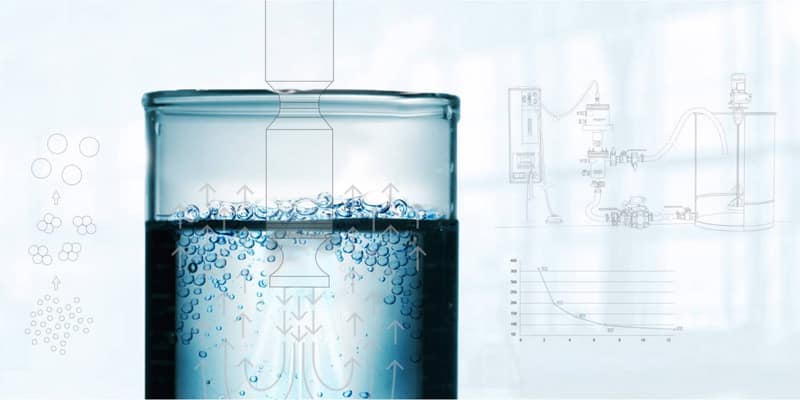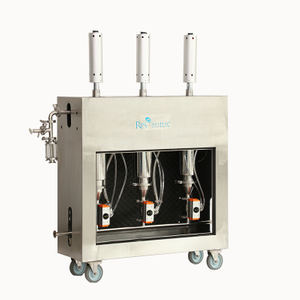Research Progress in Ultrasonic Sterilization Technology
Traditional sterilization typically uses methods such as high-temperature heating, chemical reagents, and ultraviolet light. However, high-temperature heating can destroy heat-sensitive components in objects; chemical sterilization can easily leave harmful residues; and ultraviolet sterilization has drawbacks such as incompleteness and the presence of dead zones. Consequently, researchers have been exploring and researching faster and more effective sterilization methods that avoid these limitations. Recent research has demonstrated that ultrasonic sterilization can be an effective auxiliary sterilization method, and has been successfully used in wastewater treatment and drinking water disinfection. Its application in the sterilization of liquid foods such as beer, orange juice, and soy sauce has also been extensively studied.
This article primarily introduces the mechanism of ultrasonic sterilization and reviews the research progress in ultrasonic sterilization technology and its synergistic use with other sterilization methods (lasers, microwaves, heat, and pressure).
Ultrasonic Sterilization Mechanism
Ultrasound refers to sound waves with a frequency greater than 20 kHz. Its high frequency and short wavelength not only offer excellent directionality, high power, and strong penetration, but also induce cavitation and a range of special effects, including mechanical, thermal, and chemical effects. It is generally believed that the bactericidal effect of ultrasound is primarily due to the cavitation effect it produces. During ultrasonic treatment, when high-intensity ultrasound propagates through a liquid medium, it generates longitudinal waves, which in turn create regions of alternating compression and expansion. These pressure-changing regions are prone to cavitation, forming tiny bubble nuclei within the medium. At the moment of adiabatic contraction and collapse, the tiny bubble nuclei experience temperatures exceeding 5000°C and pressures exceeding 50,000 kPa, which can kill certain bacteria in the liquid, inactivate viruses, and even damage the cell walls of smaller microorganisms. However, the range of action is limited [7,8]. Research on ultrasonic sterilization technology has been proposed as early as the 1930s. Some research results show that while the sterilization effect of ultrasound alone is limited, the combination of ultrasound and other sterilization methods has great potential and is highly effective.
Ultrasonic sterilization alone
Currently, ultrasonic sterilization is primarily used in wastewater treatment, drinking water disinfection, and the food industry, and many scholars at home and abroad have conducted related research. R. Davis used 26kHz ultrasound to kill microorganisms and found that certain bacteria, such as Escherichia coli, Bacillus megaterium, and Pseudomonas aeruginosa, were sensitive to ultrasound at low concentrations. Ultrasound, however, was less effective against Staphylococci and Streptococci, and was completely ineffective against diphtheria toxin. McClements believes that ultrasound sterilization is more effective when combined with other sterilization techniques, such as heat treatment, ozone, or chemical reagents.
In the domestic water treatment industry, improving the quality of slightly polluted water and conducting advanced treatment is a major challenge facing most water plants. Traditional wastewater sterilization methods, such as activated carbon and membrane biotechnology, have low treatment efficiency and are ineffective in removing recalcitrant organic pollutants. Related research has shown that ultrasound is effective in removing bacteria, insoluble organic matter, and color in slightly polluted water, with bacterial removal following first-order kinetics. It also has some, but not significant, effect on COD (chemical oxygen demand) and turbidity, and its effect on turbidity removal is also limited. In the food industry, food spoilage is mainly caused by the presence of certain microorganisms that change its quality. In order to ensure the safety of food, sterilization is an important link in its production. The quality of the food is directly affected by the sterilization effect. Zhu Shaohua [5] conducted a comparative test on the sterilization of soy sauce using ultrasound and found that the sterilization rate of soy sauce was 72.9% after 5 minutes of ultrasonic treatment, and 75% after 10 minutes of treatment, which was slightly lower than the sterilization rate of 78.7% at 72°C during pasteurization. When milk was sterilized with ultrasound, after 15-60 seconds of treatment, the emulsion could be stored for 5 days without becoming rancid or spoiled. If the milk was sterilized with ultrasound, it could be stored for 18 months under refrigerated conditions. The characteristics of ultrasonic sterilization are fast speed, no foreign additives, harmless to the human body, and no damage to objects. However, the sterilization effect is not thorough and there are many influencing factors. Although relevant researchers began to study ultrasonic sterilization in the early 1930s, the progress has been slow and it is still mainly used for auxiliary sterilization.
Synergistic Sterilization with Ultrasound
Research results on ultrasound sterilization alone indicate that its effectiveness is not significant and primarily serves a supporting role. Therefore, to further improve sterilization efficiency, ultrasound needs to be combined with other sterilization technologies. Researchers both domestically and internationally have conducted research on this topic. The results indicate that the combined use of ultrasound with other sterilization technologies has broad application prospects. The following is a review of recent decades of research on the sterilization effects of ultrasound in combination with ozone, nano-titanium dioxide, microwaves, lasers, ultraviolet light, heat, and pressure.
Ultrasound with Ozone
Ozone is a strong oxidant with high oxidizing properties and has long been considered a very effective oxidant and disinfectant. Ozone was already used for drinking water sterilization in the early 20th century. In 1975, Gary et al. conducted research on the synergistic effect of ultrasound and ozone on water sterilization. The results showed that ozone, when combined with ultrasound, exhibited enhanced sterilization efficacy. Hu Wenrong et al. conducted experimental studies on the ultrasound-enhanced sterilization ability of ozone, demonstrating that ultrasound significantly enhances ozone's sterilization rate. For the same treatment time, the sterilization rate using ultrasound combined with ozone is higher than that of ozone alone. When the amount of ozone used is the same, ultrasound treatment time can be shortened, thus saving ultrasonic energy. The main reason for the improved sterilization rate of the two combined is that ultrasound can break up ozone bubbles into microbubbles, significantly increasing their dissolution rate and increasing ozone concentration. High-concentration ozone can quickly oxidize and kill bacteria.
Ultrasound Combined with Nano-Titanium Dioxide
Nano-titanium dioxide has both cleansing and sterilizing properties under ultraviolet light catalysis and is widely used to clean surfaces such as ceramics, glass, and tiles. It has also attracted attention in water treatment for removing organic matter and killing bacteria in water. Similarly, nano-titanium dioxide has a sterilizing effect under ultrasound irradiation. Researchers have conducted experimental studies on the synergistic sterilization effect of nano-titanium dioxide and ultrasound. The results show that nano-titanium dioxide catalysts and ultrasound have a significant synergistic bactericidal effect. Increasing pH has a slight effect on the sterilization effect of ultrasound, and its sterilization effect is superior to that of nano-titanium dioxide catalyzed by ultraviolet light. Nano-titanium dioxide-catalyzed ultrasonic treatment not only has a strong bactericidal effect but also has a certain cleaning effect on smooth surfaces. It can be used to ultrasonically clean contaminated equipment while also achieving a sterilizing effect.
Factors Affecting Ultrasonic Sterilization Effectiveness
Experiments and related research have shown that the sterilization effectiveness of ultrasound alone varies under different conditions. Ultrasonic sterilization effectiveness is primarily influenced by factors such as the ultrasound parameters (amplitude, frequency, and duration), microbial characteristics, and the medium.
Action Parameters
Among these parameters, the amplitude, frequency, duration, and treatment temperature of the ultrasound are the main factors influencing ultrasonic sterilization.
Amplitude and Duration
The sterilization effectiveness of ultrasound against bacterial vegetative cells and spores increases exponentially with the ultrasound energy. Research has shown that the sterilization effect of ultrasound is directly proportional to the duration of the treatment; longer treatment times result in greater sterilization effectiveness. Bacterial survival rates decrease exponentially with increasing ultrasonic treatment time. However, one issue that must be addressed is that as the sterilization time increases, the temperature rise of the medium increases, which can be detrimental to some heat-sensitive substances. Sound Intensity and Frequency
For general liquids, increasing sound intensity increases cavitation intensity, but after reaching a certain value, cavitation tends to saturate. Further increasing the sound intensity at this point will generate a large number of useless bubbles, increasing scattering attenuation, reducing cavitation intensity, and ultimately decreasing the sterilization effect. Generally, to achieve satisfactory ultrasonic sterilization, it is not necessary to increase the sound intensity indefinitely; the sterilization intensity should be within the range of 1 to 61 W/cm².
Higher ultrasonic frequencies require greater sound intensity. Reports indicate that the power consumed to produce cavitation in water at a frequency of 400 kHz is 10 times greater than that consumed at 10 kHz. In other words, cavitation intensity decreases with increasing ultrasonic frequency. For this reason, the ultrasonic frequency currently used for sterilization is generally between 20 and 50 kHz.
Microbial Characteristics
All pathogens have a certain degree of resistance to ultrasound, especially when ultrasound is used alone for sterilization. It is generally believed that the larger the cell size of a microorganism, the more sensitive it is to ultrasound. This means that rod-shaped bacteria are killed faster than cocci, and large bacilli are killed faster than small bacilli. Gram-positive bacteria are more resistant than Gram-negative bacteria; aerobic bacteria are more resistant than anaerobic bacteria; and bacterial spores are more resistant than vegetative cells.
Media Factors
Lopez-Malo et al. studied the effects of pH, water activity, and temperature on the bactericidal efficacy of thermal ultrasound against Penicillium digitatum. They found that when the water activity was 0.99, increasing the ultrasound amplitude and decreasing the pH decreased the D value. When the pH remained constant and the water activity increased, the D value decreased.


 English
English














